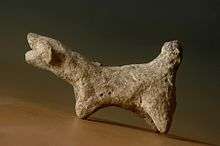Tel Tsaf

Tel Tsaf (Hebrew: תל צף) is an archaeological site located in the central Jordan Valley, south-east of Beit She'an. It was first tested in 1978–1980 by Ram Gophna of Tel Aviv University. In 2004–2007 a large excavation project was conducted at the site by Yosef Garfinkel of the Hebrew University of Jerusalem.Since 2013 the University of Haifa and the Zinman institute of archaeology started the renewed excavation of Tel Tsaf. Tel Tsaf is dated to ca. 5200–4700 BC, sometimes called the Middle Chalcolithic, a little-known period in the archaeology of the Levant,[1] post-dating the Wadi Rabah phase and pre-dating the Ghassulian Chalcolithic phase.
Discoveries
The excavations unearthed four architectural complexes. Each consists of a closed courtyard with rounded or rectangular rooms and numerous rounded silos. Four burials were found within or adjacent to silos. Outside the settlement a well was cut into the water table, approximately 6.5 m in depth.

Common finds included numerous flints, pottery and animal bones. The terms "Tel Tsaf Decoration" or "Tsafian" were derived from an assemblage of painted pottery, consisting mainly of relatively elaborate vessels bearing geometric decoration using red and black paint on a white slip background. The decoration was executed in two steps: first, white wash was applied to the upper part of the vessel, while the lower part was covered with red wash. Second, the patterns were painted in continuous horizontal bands on the upper part of the vessel. The painting was executed with a fine brush, in some cases 0.5 mm.
Other finds included about 150 clay sealings (bullae) and a rich assemblage of imported exotic items including artifacts of basalt and obsidian, beads, sea shells, Nilotic shell, and a few pottery sherds of the Ubaid culture of north Syria. This is the first reported occurrence of Ubaid sherds in an excavation in the southern Levant.
Silos
The silos are cylindrical, barrel-shaped structures with an outer diameter between 2 and 4 m. The base is a podium, probably built to protect the cereals from rodents. It consists of several courses of bricks sealed inside with lime plaster. The silos demonstrate several universal principles guiding the construction of silos worldwide, past and present: 1. Rounded sides, giving the structure a cylindrical shape. This form better withstands the pressure exerted by the contents, which is distributed evenly onto the sides of the silo and does not create excessive stress at the base or the corners as is the case with a rectilinear shape. 2. Building of a number of silos near one another allows for greater ease of handling than one big installation. This facilitates separation of grain from different years or different crops. In the event of fire, humidity, rodent or insect infestation, some of the stored grain may be spared. 3. Organization of silos in adjacent rows facilitates their arrangement within a confined space. The stability of silo shape over considerable periods of time and large geographical regions provide an outstanding case in human architecture. [2]
The renewed project
The excavations in Tel Tsaf were renewed in 2013 as a joint multidisciplinary project conducted by the Zinman Institute of Archaeology at the University of Haifa and the Eurasian Department of the German Archaeological Institute in Berlin, under the direction of Prof. Danny Rosenberg and Dr. Florian Klimsha. The main goals of this project is to explore various aspects of the Neolithic-Chalcolithic transition in the Jordan Valley by analyzing the temporal and spatial attributes of social and economic variations among households in different and new parts of the Tel and to provide better data concerning the environmental conditions and the Jordan River during the Late 6th and Early 5th Millennia Cal BC
See also
References
- ↑ Price, Meredith. "At the Bottom of the Well: The Tel-Tsaf Excavation". The Jerusalem Post. Retrieved 2010-08-08.
- ↑ Garfinkel, Yosef; David Ben-Shlomo; Tali Kuperman (2009). "Large-scale storage of grain surplus in the sixth millennium BC: the silos of Tel Tsaf". Antiquity. 83 (320): 309–326.
Bibliography
- Gophna, Ram; S. Sadeh (1988–89). "Excavations at Tel Tsaf: An Early Chalcolithic Site in the Jordan Valley". Tel Aviv. 15–16: 3–36.
- Garfinkel, Yosef; David Ben-Shlomo, M. Freikman and A. Vered (2007). "Tel Tsaf: the 2004–2006 Excavation Seasons". Israel Exploration Journal. 57: 1–33.
- Dag, D.; Yosef Garfinkel (2007). "The Flint Industry of Tel Tsaf, a Middle Chalcolithic Site in the Jordan Valley, Israel". Mitekufat Haeven (Journal of the Israel Prehistoric Society). 37: 387–424.
- Garfinkel Y., Klimsha F., Shalev S. and Rosenberg D. 2014. The beginning of metallurgy in the Southern Levant: a late 6th millennium CalBC copper awl from Tel Tsaf, Israel. PLoS ONE 9(3): e92591. doi:10.1371/journal.pone.0092591
- Gophna R. and Sadeh S. 1988-1989. Excavation at Tel Tsaf: an Early Chalcolithic site in the Jordan Valley. Tel Aviv 15-16: 3–36
- Rosenberg D., Klimscha F., Graham P. Hill C., Weissbrod L., Katlav I., Love S., Boaretto E., Pinsky S. and Hubbard E. 2014. Back to Tel Tsaf: a preliminary report on the 2013 season of the renewed project. Journal of the Israel Prehistoric Society 44: 148–179
External links
- Tel Tsaf excavation project, University of Haifa.
Coordinates: 32°24′24.46″N 35°32′53.81″E / 32.4067944°N 35.5482806°E